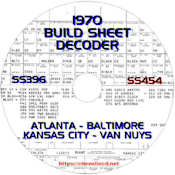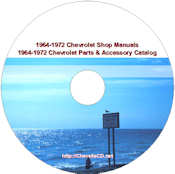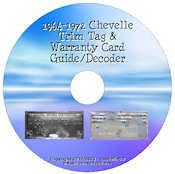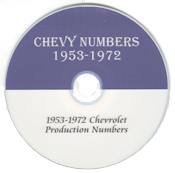ChevelleWorld
Frequently Asked Questions
Q: I have a 1969 SS 396 hardtop, how many were built?
A: Long version...
Q: Why does my 1965 283 Malibu SS not have the partial VIN stamped
on the engine pad when my friend's 1965 Malibu SS with the L79 engine
does?
A: Typically, only the high horsepower engines from 1965 through 1967
(including all SS 396 engines) got a partial VIN stamp. It is suspected
that due to a high number of early Corvettes being stolen and stripped,
one way to help recover the engines was to have the partial VIN stamped
on them. The Corvette engines were being stamped with a partial VIN
as early as 1961.
Q: My 1965 Malibu SS has a manual 3-speed transmission but no
center console, why?
A: In both 1964 and 1965 the Malibu SS came standard with bucket seat
but the center console was only added when the buyer opted for one of
the two optional transmissions - the 2-speed Powerglide or the 4-speed
manual. The standard 3-speed manual was column shifted and that did
not change with the Malibu SS; so a 3-speed manual transmission in a
Malibu SS got bucket seats but no center console.
Q: Is my Chevelle a Malibu or a Chevelle SS?
A: Short version - All Malibus are Chevelles but not all Chevelles are
Malibus. Chevrolet never had a "Chevelle SS" series; the term
used by people shortening the fact and using it as a name for this catch-all
term. Long version:
Q: My 1967 SS 396 has a bench seat. I though all SS 396 Chevelles
have bucket seats.
A: Beginning with the 1966 model year, ALL Malibus, SS-equipment optioned
Malibus and SS296 series came stand with a bench seat. Bucket seats
(RPO A51) were always an option from 1966 through 1972.
Q: My 1970 SS454 doesn't have the tach and gauges, why not?
A: Beginning with the 1966 model year, tach and gauges were optional
equipment on any V8 Malibu sport coupe, convertible, and sedan pickup
as well s 1966 through 1968 SS 396 Chevelles. If your 1970 SS454 does
not have the tach and gauges, its simply wasn't ordered.
Q: My 1968 Chevelle wasn't ordered with a radio. Does this mean
it's a radio delete car? It has a radio delete plate.
A: No. Any radio for Chevelles was an option. You can't "delete"
what wasn't ordered. The plate covering the radio hole is called a "radio
hole cover" and not a "radio delete cover." Same logic
if your Chevelle has an automatic transmission; it isn't a "4-speed
delete" car and doesn't have a "clutch pedal delete."
Q: I have a buddy with a 67 SS 396 convertible from Kansas City.
I also have a 67 SS 396 convertible from Kansas City. Our VINs are
only 30 car apart (mine is the higher of the two) yet my body number
is lower than his? How can this be?
A: See the page on "How
Chevelles Were Built" for a full explanation. You can use your
browser's "BACK" key to return here.
Q: I have a 1970 Chevelle built at Baltimore and it's build sheet. The body number on my trim tag does not match the body number on my build sheet but I know my build sheet is correct for my car. What gives?
A: The 1970 Baltimore plant used the first six digits of the data processing number (box #24) on their trim tags. For what it's worth, the Body Number in box #8 is not sequential as one might have though. As an example, I have in my database of Baltimore build sheets a Chevelle with build sheet dates of 69 12-08 and 83 01-05 with tithe same body number on the build sheet of BB00017. For more information see the page "Fisher Body Numbers."
Say you saw it here on © ChevelleWorld





Want more in-depth information on 1964-1972 Chevelles? My 1970 SS 396/SS454
Build Sheet Decode Program CD, Shop Manuals & Parts Catalog program DVD, Facts and SS
Guide program CD, 1964-1972 Trim Tag and Protect-O-Plate program CD,
and my Chevy Numbers program CD. Check
them and other informative program CDs at my
https://chevellecd.net website.

 1964 Chevelle
1964 Chevelle 1965 Chevelle
1965 Chevelle 1966 Chevelle
1966 Chevelle 1967 Chevelle
1967 Chevelle 1968 Chevelle
1968 Chevelle 1969 Chevelle
1969 Chevelle 1970 Chevelle
1970 Chevelle 1971 Chevelle
1971 Chevelle 1972 Chevelle
1972 Chevelle


